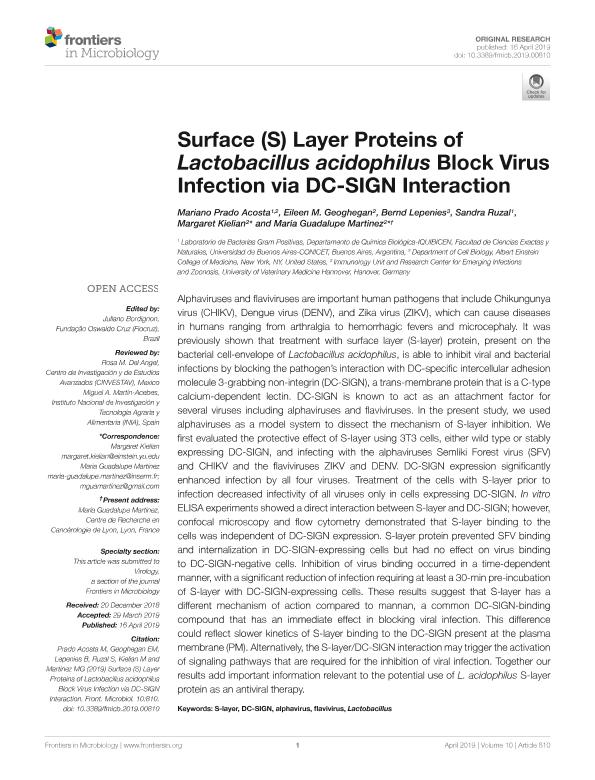Mostrar el registro sencillo del ítem
dc.contributor.author
Prado Acosta, Mariano

dc.contributor.author
Geoghegan, Eileen M.
dc.contributor.author
Lepenies, Bernd
dc.contributor.author
Ruzal, Sandra Mónica

dc.contributor.author
Kielian, Margaret
dc.contributor.author
Martinez, Maria Guadalupe
dc.date.available
2021-01-21T13:02:48Z
dc.date.issued
2019-04
dc.identifier.citation
Prado Acosta, Mariano; Geoghegan, Eileen M.; Lepenies, Bernd; Ruzal, Sandra Mónica; Kielian, Margaret; et al.; Surface (S) Layer Proteins of Lactobacillus acidophilus Block Virus Infection via DC-SIGN Interaction; Frontiers Media S.A.; Frontiers in Microbiology; 10; MAR; 4-2019; 1-12
dc.identifier.issn
1664-302X
dc.identifier.uri
http://hdl.handle.net/11336/123281
dc.description.abstract
Alphaviruses and flaviviruses are important human pathogens that include Chikungunya virus (CHIKV), Dengue virus (DENV), and Zika virus (ZIKV), which can cause diseases in humans ranging from arthralgia to hemorrhagic fevers and microcephaly. It was previously shown that treatment with surface layer (S-layer) protein, present on the bacterial cell-envelope of Lactobacillus acidophilus, is able to inhibit viral and bacterial infections by blocking the pathogen’s interaction with DC-specific intercellular adhesion molecule 3-grabbing non-integrin (DC-SIGN), a trans-membrane protein that is a C-type calcium-dependent lectin. DC-SIGN is known to act as an attachment factor for several viruses including alphaviruses and flaviviruses. In the present study, we used alphaviruses as a model system to dissect the mechanism of S-layer inhibition. We first evaluated the protective effect of S-layer using 3T3 cells, either wild type or stably expressing DC-SIGN, and infecting with the alphaviruses Semliki Forest virus (SFV) and CHIKV and the flaviviruses ZIKV and DENV. DC-SIGN expression significantly enhanced infection by all four viruses. Treatment of the cells with S-layer prior to infection decreased infectivity of all viruses only in cells expressing DC-SIGN. In vitro ELISA experiments showed a direct interaction between S-layer and DC-SIGN; however, confocal microscopy and flow cytometry demonstrated that S-layer binding to the cells was independent of DC-SIGN expression. S-layer protein prevented SFV binding and internalization in DC-SIGN-expressing cells but had no effect on virus binding to DC-SIGN-negative cells. Inhibition of virus binding occurred in a time-dependent manner, with a significant reduction of infection requiring at least a 30-min pre-incubation of S-layer with DC-SIGN-expressing cells. These results suggest that S-layer has a different mechanism of action compared to mannan, a common DC-SIGN-binding compound that has an immediate effect in blocking viral infection. This difference could reflect slower kinetics of S-layer binding to the DC-SIGN present at the plasma membrane (PM). Alternatively, the S-layer/DC-SIGN interaction may trigger the activation of signaling pathways that are required for the inhibition of viral infection. Together our results add important information relevant to the potential use of L. acidophilus S-layer protein as an antiviral therapy.
dc.format
application/pdf
dc.language.iso
eng
dc.publisher
Frontiers Media S.A.

dc.rights
info:eu-repo/semantics/openAccess
dc.rights.uri
https://creativecommons.org/licenses/by/2.5/ar/
dc.subject
ALPHAVIRUS
dc.subject
DC-SIGN
dc.subject
FLAVIVIRUS
dc.subject
LACTOBACILLUS
dc.subject
S-LAYER
dc.subject.classification
Virología

dc.subject.classification
Ciencias Biológicas

dc.subject.classification
CIENCIAS NATURALES Y EXACTAS

dc.title
Surface (S) Layer Proteins of Lactobacillus acidophilus Block Virus Infection via DC-SIGN Interaction
dc.type
info:eu-repo/semantics/article
dc.type
info:ar-repo/semantics/artículo
dc.type
info:eu-repo/semantics/publishedVersion
dc.date.updated
2020-12-01T16:29:08Z
dc.journal.volume
10
dc.journal.number
MAR
dc.journal.pagination
1-12
dc.journal.pais
Suiza

dc.journal.ciudad
Lausanne
dc.description.fil
Fil: Prado Acosta, Mariano. Consejo Nacional de Investigaciones Científicas y Técnicas. Oficina de Coordinación Administrativa Ciudad Universitaria. Instituto de Química Biológica de la Facultad de Ciencias Exactas y Naturales. Universidad de Buenos Aires. Facultad de Ciencias Exactas y Naturales. Instituto de Química Biológica de la Facultad de Ciencias Exactas y Naturales; Argentina. Albert Einstein College of Medicine; Estados Unidos
dc.description.fil
Fil: Geoghegan, Eileen M.. Albert Einstein College of Medicine; Estados Unidos
dc.description.fil
Fil: Lepenies, Bernd. University of Veterinary Medicine Hannover; Alemania
dc.description.fil
Fil: Ruzal, Sandra Mónica. Consejo Nacional de Investigaciones Científicas y Técnicas. Oficina de Coordinación Administrativa Ciudad Universitaria. Instituto de Química Biológica de la Facultad de Ciencias Exactas y Naturales. Universidad de Buenos Aires. Facultad de Ciencias Exactas y Naturales. Instituto de Química Biológica de la Facultad de Ciencias Exactas y Naturales; Argentina
dc.description.fil
Fil: Kielian, Margaret. Albert Einstein College of Medicine; Estados Unidos
dc.description.fil
Fil: Martinez, Maria Guadalupe. Albert Einstein College of Medicine; Estados Unidos
dc.journal.title
Frontiers in Microbiology
dc.relation.alternativeid
info:eu-repo/semantics/altIdentifier/url/https://www.frontiersin.org/article/10.3389/fmicb.2019.00810/full
dc.relation.alternativeid
info:eu-repo/semantics/altIdentifier/doi/http://dx.doi.org/10.3389/fmicb.2019.00810
Archivos asociados
